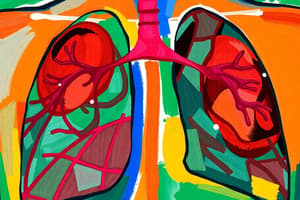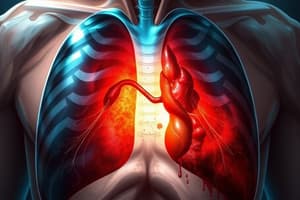Podcast
Questions and Answers
Which of the following is NOT a correct statement about this type of pneumothorax?
Which of the following is NOT a correct statement about this type of pneumothorax?
- Smoking increases the chances of a patient developing a spontaneous pneumothorax.
- It can occur in patients who are young, tall and thin without a history of lung disease.
- It is most likely to occur in patients with COPD, asthma, and cystic fibrosis. (correct)
- It can be caused by the rupture of a pulmonary bleb.
When charting findings for a patient with 'bulging' areas of skin on the neck, face, and abdomen that feel 'crunchy', what term would be used?
When charting findings for a patient with 'bulging' areas of skin on the neck, face, and abdomen that feel 'crunchy', what term would be used?
- Veisalgia
- Pigment molle
- Subcutaneous emphysema (correct)
- Subcutaneous paresthesia
If a patient with a pneumothorax has a chest tube with no fluctuation of water in the water seal chamber, what should your next action be?
If a patient with a pneumothorax has a chest tube with no fluctuation of water in the water seal chamber, what should your next action be?
- Keep monitoring the patient because this is a normal finding.
- Assess patient's lung sounds to assess if the affected lung has re-expanded. (correct)
- Notify the physician.
- Increase wall suction to the system until the water fluctuates in the water seal chamber.
Select ALL the signs and symptoms that can present with tension pneumothorax.
Select ALL the signs and symptoms that can present with tension pneumothorax.
Which finding during the assessment of a patient with a chest tube for pneumothorax requires immediate nursing intervention?
Which finding during the assessment of a patient with a chest tube for pneumothorax requires immediate nursing intervention?
Which statement is CORRECT about a tension pneumothorax?
Which statement is CORRECT about a tension pneumothorax?
What is your next PRIORITY if a drainage system for a pneumothorax has fallen on its side with a large crack in it?
What is your next PRIORITY if a drainage system for a pneumothorax has fallen on its side with a large crack in it?
What is pneumothorax?
What is pneumothorax?
What is closed pneumothorax?
What is closed pneumothorax?
What defines open pneumothorax?
What defines open pneumothorax?
What is hemothorax?
What is hemothorax?
The rib fractures are most commonly fractured because they are the least protected by chest muscles. Rib fractures are most commonly fractured are ribs ___
The rib fractures are most commonly fractured because they are the least protected by chest muscles. Rib fractures are most commonly fractured are ribs ___
What are the risk factors for hemothorax and pneumothorax?
What are the risk factors for hemothorax and pneumothorax?
What is flail chest?
What is flail chest?
Match the following with their definitions:
Match the following with their definitions:
A chest tube will be placed __ in the lung with the presence of a pneumothorax (approximately 2nd intercostal space).
A chest tube will be placed __ in the lung with the presence of a pneumothorax (approximately 2nd intercostal space).
A chest tube will be placed __ in the lung with the presence of a hemothorax (approximately 5th intercostal space).
A chest tube will be placed __ in the lung with the presence of a hemothorax (approximately 5th intercostal space).
What are the signs and symptoms of cardiac tamponade?
What are the signs and symptoms of cardiac tamponade?
What is Beck's triad of cardiac tamponade?
What is Beck's triad of cardiac tamponade?
Which of the following is considered an indication for open thoracotomy?
Which of the following is considered an indication for open thoracotomy?
What is tension pneumothorax?
What is tension pneumothorax?
What is the primary treatment for tension pneumothorax?
What is the primary treatment for tension pneumothorax?
What are common signs and symptoms of tension pneumothorax?
What are common signs and symptoms of tension pneumothorax?
Which of the following is a LATE sign of the development of a tension pneumothorax?
Which of the following is a LATE sign of the development of a tension pneumothorax?
What is the treatment for hemothorax?
What is the treatment for hemothorax?
What medications can be used for chest trauma?
What medications can be used for chest trauma?
What is rib fracture management?
What is rib fracture management?
What is the definition of chylothorax?
What is the definition of chylothorax?
MVA are responsible for 80% of blunt chest traumas.
MVA are responsible for 80% of blunt chest traumas.
Negative pressure exists between visceral and parietal pleura to assist lung expansion.
Negative pressure exists between visceral and parietal pleura to assist lung expansion.
What is the significance of rapid, shallow respirations in the context of chest trauma?
What is the significance of rapid, shallow respirations in the context of chest trauma?
Study Notes
Pneumothorax
- Occurs when air leaks into the pleural space, leading to lung collapse.
- Closed pneumothorax: Air enters pleural space through a lung opening.
- Open pneumothorax: Air enters pleural space via an open chest wound.
Hemothorax
- Blood accumulates in the pleural space.
- Common risk factors include blunt and penetrating trauma, occluded chest tubes, and COPD.
Flail Chest
- Characterized by multiple rib fractures, causing a segment of the chest wall to detach.
- Leads to paradoxical chest movement, crepitus, and asymmetric expansion.
Cardiac Tamponade
- Acute heart compression due to fluid in the pericardial cavity.
- Causes decreased cardiac filling and output, leading to pulmonary and venous congestion.
- Beck's triad: Hypotension, muffled heart sounds, elevated neck veins.
Diagnostic Procedures
- CT scan: Gold standard for diagnosing pneumothorax.
- Chest tube placement: For pneumothorax (2nd intercostal space) and hemothorax (5th intercostal space).
Treatment Modalities
- Pneumothorax: Can heal on its own; options include thoracentesis, chest tube insertion, and pleurodesis.
- Hemothorax: Treated with chest tube drainage, possible autotransfusion, and supportive measures.
- Cardiac tamponade: Managed through pericardiocentesis and possibly surgical repair.
Signs and Symptoms
- Pneumothorax: Symptoms vary; include dyspnea, chest pain, absent breath sounds, and hypoxemia.
- Hemothorax: Present with dyspnea, dullness to percussion, decreased hemoglobin, and shock.
- Cardiac Tamponade: Presents with muffled heart sounds, tachycardia, hypotension, and neck vein distention.
- Flail Chest: Rapid, shallow breaths, crepitus, and splinting behavior.
Types of Trauma
- Blunt Trauma: Can cause significant internal injuries without visible external damage.
- Penetrating Trauma: Involves open wounds from objects like knives or bullets, leading to significant internal compromise.
Complications
- Tension pneumothorax: Air enters the pleural space and cannot escape, leading to increased pressure, lung collapse, and mediastinal shift.
- Symptoms include severe dyspnea, tachycardia, tracheal deviation, and hypotension.
Interventions
- Immediate interventions for tension pneumothorax include needle decompression and chest tube insertion.
- For chest trauma, focus on airway management, supplemental oxygen, and IV access for fluid resuscitation.
Nursing Considerations
- Monitor vital signs, consciousness, oxygen saturation, and cardiac rhythm.
- Educate patients on signs of complications and the importance of follow-up.
- Avoid strapping or binding the chest due to the risk of atelectasis.
Risk Factors & Prevention
- Bleb formation: Associated with spontaneous pneumothorax risk, particularly in tall, thin, young males, and smokers.
- Iatrogenic pneumothorax: Can occur from medical interventions like central line placement or thoracentesis.
Medications & Management
- Use benzodiazepines and opioid agonists for pain management in chest trauma.
- Encourage deep breathing and coughing to prevent complications like atelectasis and pneumonia following rib fractures.### Tension Pneumothorax
- Tracheal deviation to the right indicates possible tension pneumothorax.
- Pressure builds in the intrapleural space due to a one-way valve effect from an opening, shifting the mediastinum.
- Considered a medical emergency requiring immediate treatment, typically needle decompression.
- Early sign includes tracheal deviation.
Chest Tube Complications
- Fluctuation in the water seal chamber is normal with patient respiration.
- Tenderness at the chest tube insertion site should be monitored and evaluated.
- If a chest drainage system is compromised (e.g., cracked or fallen), prioritize patient safety.
- Correct response involves inserting disconnected tubing into sterile water and acquiring a new drainage system.
Studying That Suits You
Use AI to generate personalized quizzes and flashcards to suit your learning preferences.
Description
This quiz focuses on flashcards covering various conditions related to pneumothorax, hemothorax, tension pneumothorax, and flail chest. Ideal for medical students or healthcare professionals looking to reinforce their knowledge on respiratory emergencies.



